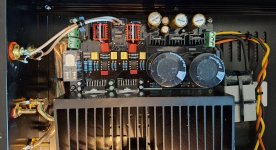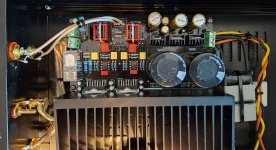Good catch.
I'm not sure how to read that.
I think they meant to say "when" +VS and -VS are applied.
The OPs device failed "while" +VS and -VS were applied "while" playing a record. That's what super-odd.
What does extreme and rare mean?
If it can happen "while" +VS and -VA are applied it would seem to be, and in the OP's case was, spontaneous. Not good.
Seems to make an argument for series resistors in the supply leads but how large? They don't say what the maximum dissipation in crowbar mode is.
I don't use the OPA161X and can't see ever using it connected directly to a transducer if it can spontaneously self-destruct. But hey it's safe from ESD.
Quoting TI: "In extreme but rare cases, the absorption device triggers on while +VS and –VS are applied." If this event happens, a direct current path is established between the +VS and –VS supplies. The power dissipation of the absorption device is quickly exceeded, and the extreme internal heating destroys the operational amplifier.
I'm not sure how to read that.
I think they meant to say "when" +VS and -VS are applied.
The OPs device failed "while" +VS and -VS were applied "while" playing a record. That's what super-odd.
What does extreme and rare mean?
If it can happen "while" +VS and -VA are applied it would seem to be, and in the OP's case was, spontaneous. Not good.
Seems to make an argument for series resistors in the supply leads but how large? They don't say what the maximum dissipation in crowbar mode is.
I don't use the OPA161X and can't see ever using it connected directly to a transducer if it can spontaneously self-destruct. But hey it's safe from ESD.
My thought was the transient may have driven an output ESD diode, not an input ESD diode, into conduction triggering the crowbar.That would require that the cartridge produced a voltage that exceeded the power supply voltage by enough to forward bias the ESD diodes on the input pin and enough current to charge the supply capacitance at a fast enough rate to trigger the rail clamp. That seems unlikely. Clicks and pops have pretty steep edges, but they're not that steep.
Off topic: the local radio station here used to have a computer with a video digitizing card with a Conexant Fusion IC on it. The card was connected to a surveillance camera which produced an ordinary composite video signal.
Connecting and powering up the computer and camera had to be done in a specific order, otherwise the video digitizing card would fail immediately. That had happened a few times. In at least one case, the package of the Conexant Fusion IC bursted.
Connecting and powering up the computer and camera had to be done in a specific order, otherwise the video digitizing card would fail immediately. That had happened a few times. In at least one case, the package of the Conexant Fusion IC bursted.
This may be the first op-amp to win the Burning Amp award. 😉Here's what the OPA1611 datasheet says in the first text portion on page 14 (rev. Aug 2014):
In extreme but rare cases, the absorption device triggers on while +VS and –VS are applied. If this event happens, a direct current path is established between the +VS and –VS supplies. The power dissipation of the absorption device is quickly exceeded, and the extreme internal heating destroys the operational amplifier.
Ed
Huh, what?Stll nobody checked the actual power supply voltage on that unit ...
Ok, thank you, I will check this and monitor power rails.
I’m baffled with this dead horse beating and flow of wild theories while it is crystal clear what happened.
There is big posibility of static buildup on stylus during LP playback, and as all the parts are metal there is chance that static spark jumped to cratridge coil in burned OPs internal clamping diode🤦
It is very easy to burn TI opamp with no current limiting resistor at input. I have burned a ‘fistful’ during breadboard tinkering, always by accidentally applying over the rails voltage direct at input pin. In all cases chip was fried and most of them measure low resistance between supply pins.
In any case where you need/want to use any signal input with no series resistor, adding external beefier protection diodes in parallel with internal ones, will save the day.
Not MC cartridge as an overvoltage source but static buildup during LP playback. Failure occurred during playback and it was during winter period while air humidity is very low.
No to mention that he had to repair the same error in several different commercial phono circuits with OPA1611 and 1641.
No to mention that he had to repair the same error in several different commercial phono circuits with OPA1611 and 1641.
According to post #3, there was an external ESD protection network; apparently a secret one, as the thread starter refused to give any details...
"Fried" and "low resistance between supply pins" sounds like latch-up to me, although it could also be due to an ESD supply clamp that keeps conducting when triggered. A short from an input to the supply, like the thread starter had, could be plain ESD damage.
"Fried" and "low resistance between supply pins" sounds like latch-up to me, although it could also be due to an ESD supply clamp that keeps conducting when triggered. A short from an input to the supply, like the thread starter had, could be plain ESD damage.
On an ESD pulse with rise times of a few ns, wiring and MM cart inductance would offer little protection. Dedicated ESD protection diodes feature ultra-low capacitance and small low L packages for that very reason and have to be carefully placed to be of benefit. See Nexperia, ON and Rohm for examples.
For direct coupled MC inputs as in trans impedance amplifiers, anti-parallel diodes across the inputs are a good solution. Although clamping at a few volts, the total energy in the pulse is low and means it will still only be a few ms long which a MC cart should handle with ease.
For direct coupled MC inputs as in trans impedance amplifiers, anti-parallel diodes across the inputs are a good solution. Although clamping at a few volts, the total energy in the pulse is low and means it will still only be a few ms long which a MC cart should handle with ease.
Ich hatte einen Composite-Feedback-Verstärker mit dem TDA7293 gebaut und zwei OPA1611 als Operationsverstärker verwendet. Der Klang wirkte etwas instabil. Ich schaltete den Verstärker ein, und eine Seite zischte nur! Jetzt habe ich zwei Burson Audio V7 Vivid Singles eingebaut. Die waren zwar nicht meine erste Wahl, klingen aber deutlich besser. Jetzt muss ich mal darüber nachdenken...
I had built a composite feedback amplifier with the TDA7293, and I used two OPA1611s as op-amps. The sound seemed a bit unstable. I just turned on the amplifier, and one side was just hissing! Now I've installed two Burson Audio V7 Vivid singles. They weren't my first choice, but they sound considerably better. Now I have to think about it...

I had built a composite feedback amplifier with the TDA7293, and I used two OPA1611s as op-amps. The sound seemed a bit unstable. I just turned on the amplifier, and one side was just hissing! Now I've installed two Burson Audio V7 Vivid singles. They weren't my first choice, but they sound considerably better. Now I have to think about it...
Attachments
I had built a composite feedback amplifier with the TDA7293, and I used two OPA1611s as op-amps. The sound seemed a bit unstable. I just turned on the amplifier, and one side was just hissing! Now I've installed two Burson Audio V7 Vivid singles. They weren't my first choice, but they sound considerably better. Now I have to think about it...

Attachments
Just my 2¢:
I read that someone had made a power supply with one of those modern automotive mosfets, those that move from non-conductive to fully open with 10mΩ resistance, in a delta of < 50mV at the threshold: when such a part is used in a power supply, as a source-follower, then this very fast switching might give inductive spikes. He measured spikes of 1.500V for just a nanosec or two.
If that were the case -
I read that someone had made a power supply with one of those modern automotive mosfets, those that move from non-conductive to fully open with 10mΩ resistance, in a delta of < 50mV at the threshold: when such a part is used in a power supply, as a source-follower, then this very fast switching might give inductive spikes. He measured spikes of 1.500V for just a nanosec or two.
If that were the case -
- . . Now that might trigger the ESR circuit, as I understand from some posts above - and bring the whole OPA1611 input into a strange state.
I know this is an old thread and I've been out of touch with modern OPA stuff for some time but ...
Anyone know if OPA1611 & 1641 were originally Burr Brown devices?
I ask cos after the EVIL Texans bought NS, support for the NS devices weren't as good as under previous NS management.
My experience was with LM 4562 which Self and others have touted as the best thing since sliced bread. I found latch up in certain filter configurations and also single supply applications when it wouldn't start up.
Wayne Kirkwood investigated this in detail and found it manifested itself when the feedback resistors were high value. He brought this up in some TI support forums where they eventually admitted, this was a problem. But the datasheet still makes no mention of this 'feature'.
But then again, the ancient TI TL07x series have a well known (sorta similar but not identical) latch-up behaviour ... which isn't mentioned in the datasheets either.
At least OPA1611 datasheet warns of possible catastrophic failure .. #98
Anyone know if OPA1611 & 1641 were originally Burr Brown devices?
I ask cos after the EVIL Texans bought NS, support for the NS devices weren't as good as under previous NS management.
My experience was with LM 4562 which Self and others have touted as the best thing since sliced bread. I found latch up in certain filter configurations and also single supply applications when it wouldn't start up.
Wayne Kirkwood investigated this in detail and found it manifested itself when the feedback resistors were high value. He brought this up in some TI support forums where they eventually admitted, this was a problem. But the datasheet still makes no mention of this 'feature'.
But then again, the ancient TI TL07x series have a well known (sorta similar but not identical) latch-up behaviour ... which isn't mentioned in the datasheets either.
At least OPA1611 datasheet warns of possible catastrophic failure .. #98
- Home
- Design & Build
- Parts
- OPA1611 & OPA1641 dangerous failures

